Significant Monument Collection
Hannah Adams Monument – Lot 180 Central Avenue
1832 Neoclassical Marble Pedestal Monument
Carvers: Alpheus Cary (1788-1869) & Dickinson
The first monument erected at Mount Auburn commemorates historian and author Hannah Adams (1755-1831), once among the most famous women in America. The monument immediately became a model for cemetery monuments throughout the country, and was often illustrated in guidebooks and advertisements for 19th-century monument makers. Conserved in 2009.
Samuel Appleton Monument – Lot 464 Woodbine Path
1834 Italian Marble Temple with Egyptian Revival Symbolism
The American merchant and philanthropist Samuel Appleton (1766-1853) imported his family monument at Mount Auburn from Italy at the original cost of $10,000. The unique, large tomb sits on the crest of Cedar hill near the highest point of the Cemetery.
Atkins Children – Lot 2339 Lime Avenue
1856 Marble Sculpture of three small children
Sculptor: Peter Stephenson (1823-1861)
A portrait statue signed by the sculptor that depicts the children of Elisha Atkins: Willie, Mary, and Charles Atkins looking heavenward. Before 1850, a third of all burials were for children under the age of five.
Rev. Hosea Ballou Monument – Lot 103 Central Avenue
1859 Portrait Statue, in Vermont Marble on a granite base
Sculptor: Edward Augustus Brackett (1818-1908), “One of our best native sculptors.”
Rev. Hosea Ballou was a renowned American Universalist minister, theologian, and author. His portrait statue at Mount Auburn portrays him in the “full vigor of adulthood,” a notable New Englander, carved from New England marble, by the hands of a New England sculptor who, unlike most, did not go to Italy to learn his craft. A larger than life portrait, the statue standing on its base is 14 feet high. “The most interesting of all Boston statues…To us it is the clearest beginning of primitive portrait sculpture in America.” (T.H. Bartlett, American Art & Arch., 1891). Cleaned and pointed in 2010.
Amos Binney Monument – Lots 1390 and 1391 Heath Path
1847 Large Neoclassical Monument of Italian Marble with back-to-back niches
Sculptor: Thomas Crawford (1813-1857)
Designated a National Treasure by the White House Millennium Committee to Save Outdoor Sculpture, this artistic monument is considered one of the outstanding works of funerary art in this country. Commissioned by widow Mary Ann Binney in 1847 for her husband Amos Binney (1803-1847), the memorial is a landmark in the development of American artistic taste, combining neoclassical ideals and republican aspirations. Amos Binney was a founder and president of the Boston Society of Natural History, philanthropist, and art collector. Carved in Rome, Italy, this is Crawford’s only realized work of funerary art and the Cemetery’s highest priority for conservation. In urgent need of conservation.
Edwin Booth Monument – Lot 3281 Anemone Path
1894 Marble Monolith with bronze bas-relief
Architect and Designer: Stanford White (1853-1906), McKim Mead and White
Portrait Sculptor: Frank Edwin Elwell (1858-1922)
Carvers: Initially by Fritsch marble works; in 1911 by John Evans
An Athenian style monument commemorating Edwin Booth (1833-1893), the great Shakespearean actor, “Prince of Players,” and the brother of John Wilkes Booth who assassinated President Lincoln. The masks of comedy and tragedy, designed by Saint Gaudens, are carved on the back of the monument. The bronze portrait represents Booth “at the prime of his life.”
Nathaniel Bowditch Monument
1847 Bronze Portrait Statute surmounted on a granite pedestal. Original casting in 1847; second casting in 1886 in Paris.
Sculptor: R. Ball Hughers (1806-1868)
The famous navigator, astronomer, and self-taught mathematician Nathaniel Bowditch (1773-1838) epitomized the type of New England citizen admired by the Cemetery’s founders. As the first full-scale bronze statue cast in this country, the statue also represented the latest advances of art and industry. Called “the best sculpture of its kind in America,” by architect and critic Hammatt Billings, the Bowditch portrait is thought by many to be Hughes’ finest work. Nathaniel Bowditch is buried elsewhere in his family lot on Tulip Path. Conserved in 2011 through institutional funds, in partnership with the conservation of the original plaster cast at the Boston Athenaeum.
Charles Bulfinch Monument – Lot 2308 Bellwort Path
1858 Neoclassical Limestone Urn surmounted on a granite pedestal
Charles Bulfinch (1763-1844) was among the first American-born architects of distinction and was the third Architect of the U.S. Capitol. He purchased this urn, known as the “Franklin Urn,” in Europe for his monument to Benjamin Franklin in Boston’s Tontine Crescent which he designed. The Urn was later place on his grave. Conserved in 1993 through private donations.
Peter Byus Monument – Lot 3752 Magnolia Avenue
1867 Marble Headstone with bas-relief of kneeling male slave with broken shackles
Fugitive slave Peter Byus (1801-1867) was born in Virginia and fled to Boston for his freedom. The low-relief carving on his monument shows a kneeling male figure in shackles that have been broken, an image inspired by a cameo by Josiah Wedgwood that he created for the Quaker-based Society for Effecting the Abolition of the Slave Trade.
William Ellery Channing Monument – Lot 678 Greenbrier Path
1847 Neoclassical Sarcophagus in Italian Marble of unique design
Designer: Washington Allston (1779-1843)
Carver: Alpheus Cary (1788-1869)
The monument to Revered William Channing, Unitarian clergyman, social reformer, and author, was designed by his brother-in-law, the noted American artist Washington Allston.
Jonas Chickering Monument – Lot 2282 Magnolia Avenue
1872 Italian Marble Sculpture depicting the Angel of Death with Kneeling Figure on a large granite pedestal with inset marble tondo titled “Realization of Faith”
Sculptor: Thomas Ball (1819-1911)
This monument to Jonas Chickering (1799-1853), a noted piano manufacturer and musician, was created by leading American sculptor Thomas Ball who carved this work of art in his studio in Florence, Italy.
Maria Frances Coppenhagen Monument – Lot 3733 Sycamore Path
1872 Marble Portrait Statue of a Standing Angel with bronze trumpet
Sculptor: Martin Milmore (1844-1883)
The sculpted angel to “My beloved daughter Maria West” was commissioned by the Coppenhagen family and carved by Boston’s leading sculptor in the decades surrounding the Civil War.
Mary Baker Eddy Monument – Lot 6234 Halcyon Avenue
1917 Circular Colonnade in Bethel White Granite
Architect: Egerton Swartwout (1870-1943)
Perhaps the most photographed subject in the Cemetery, this fifteen foot Classical structure overlooking Halcyon Lake was commissioned by the First Church of Christ Scientist, to commemorate their founder Mary Baker Eddy (1821-1910). Architect Swartwout won the design competition in 1914 and used as his prototype the Temple of the Winds in Athens, Greece. The ornament was carved by thirty-four marble carvers from Northern Italy brought to the US by the Menconi Brothers, NY. The memorial has been acknowledged as one of the finest examples of granite carving in the nation.
Hezekiah Eldredge Monument – Lot 994 Eglantine Path
1845 Granite Pedestal with Marble Inset titled “Christ Blessing the Little Children”
Sculptor: Henry Kirke Browne (1814-1886)
Published in “The Garden Cemetery and American Sculpture: Mount Auburn,” by Frederic A. Sharf, as an example of Mount Auburn Cemetery’s transformation from rural cemetery to “sculptured garden.”
Beatrice Fagnani Monument – Lot 818 Greenbrier Path
1857 Marble Sculpture of morning glory flower
Located in the lot of celebrated portrait painter Joseph Fagnani, this delicate marble carving of a morning glory flower commemorates his child Beatrice Fagnani. This monument is an example of vernacular carving by an unknown artist.
First Corps of Cadets Monument – Lot 3215 Lawn Avenue
1867 Monument in Italian Marble and White Concord granite, twenty-two feet high
Granite Carver: Mr. D.C. Hutchinson; Granite contracted by Thomas Hollis
Architect/Designer: Theodore E. Colburn, Boston
Sculptor of eagle and tablets: Garrett Barry (modeled and cut), Quincy
Erected by the Independent Corps of Cadets to honor the heroism of the fifteen members of the Corps who lost their lives in the “War of Rebellion” in November 1865. Cleaned and pointed in 2003 with funds from the First Corps of Cadets.
Francis Calley Gray Monument – Lot 1087 Hemlock Path
1837 Italian Marble Statue of Recumbent Dog
Sculptor: Joseph Gott (1785-1860)
Carved in Rome, this “English setter” lawn dog was commissioned by Gray in 1849 and given to William Appleton. Appleton later had the dog placed on his friend’s grave at Mount Auburn after his death in 1857.
William Frederick Harnden Monument – Lot 886 Central Avenue
1866 Large Granite Canopy with Marble Urn, statue of dog and bas-reliefs
Sculptor: Thomas A. Carew (1819-1894)
Commissioned by the Express Companies of the United States to commemorate William Frederic Harnden (1812-1845) who pioneered express services between Boston and New York in 1839. The bold and complex monument is laden with symbolism and replaces a simple marble stone: two marble panels illustrate the ending and receiving of packages. The English mastiff dog is a symbol of fidelity.
Hygeia Statue – Harriot Kezia Hunt Lot 2630 Poplar Avenue
1870 Italian Marble Statue of Hygeia
Sculptor: Edmonia Lewis (1843 or 1845-after 1909)
Pioneering physician and feminist reformer Harriot Kezia Hunt (1805-1875) commissioned Lewis to create a statue of Hygeia, the Greek goddess of health & hygiene, for her lot at Mount Auburn. Hunt had a hand in the design. Lewis was the first American of color – man or woman – to receive international recognition as a sculptor in Rome, Italy. Lewis’ father was African American and her mother was of Ojibwa descent. She was known for the naturalism she brought to the neoclassical style, and for her depiction of human rights issues. Conserved in 2008 through private donations.
Henry Wadsworth Longfellow Monument – Lot 580 Indian Ridge Path
Ca. 1883-1890 Indiana Limestone Sarcophagus
Architect/Designer: William Pitt Preble Longfellow (1836-1913)
Sculptor of plaque: Richard Henry Dana, Jr. (1815-1882)
Henry Wadsworth Longfellow (1807-1882) was the most famous and popular poet of the 19th century. The monument was designed by Longfellow’s nephew. Inscribed on the plaque is the Latin: “Dux, Lex, Lux and Rex” which translates to: “Leader, Law, Light and King.”
Thatcher Magoun Monument – Lot 1792 Fir Avenue
1851 Marble Sculpture on marble base of kneeling woman and child
Signed on the Base: R. Barry, Boston
Inspired by a relief carving by British sculptor John Henry Foley, this marble statue commemorates Medford shipbuilder Thatcher Magoun (1775-1862) and was photographer in the studio by the daguerrotypists Southworth and Hawes in 1852. In urgent need of conservation.
Henry Coffin Nevins Monument – Lot 4659 Eagle Avenue
1892 Limestone Ledger stone with headboard of two angels
Sculptor: Augustus Saint-Gaudens (1848-1907)
Architect/Designer: Stanford White
Augustus Saint-Gaudens was a famous sculptor in the Beaux Arts style, well known for works such as the statue to Robert Gould Shaw on the Boston Common. Stanford White was a well-known architect in the American Renaissance style, and a partner in the firm McKim, Mead and White.
Thomas Handasyd Perkins Monument – Lot 108 Central Avenue
1843 Italian Marble Statue of a dog
Sculptor: Horatio Greenough (1805-1852)
Commissioned from Greenough by “The Merchant Prince” of the China trade, Thomas Handasyd Perkins, this marble dog was placed at Mount Auburn in 1844. Horatio Greenough was the first American sculptor to live in Italy. Considered “America’s first sculptor,” Greenough is known for his famous portrait statue of George Washington now in the Smithsonian Institution.
Olive L. Rich Monument – Lot 3465 Garden Avenue
1864 Italian Marble sculpture of a kneeling woman on a pedestal
This statue commemorating Olive L. Rich (1831-1863) is copied from Lorenzo Bartolini’s 1835 statue titled “Trust in God,” in the collections of the Museo Poldi Pezzoli, Milan. Conserved in 2010 through an individual donation.
Robert Gould Shaw Monument – Lot 1286 Pine Avenue
1848 Large Brownstone Canopy with Italian marble, ancient marble, slate and bronze
Architect/Designer: Hammatt Billings (1818-1874)
Carver: Alpheus Cary (1788-1869)
Erected by Boston merchant Robert Gould Shaw (1776-1853) for his family lot at Mount Auburn. Robert Gould Shaw’s grandson, Civil War Colonel Robert Gould Shaw (1837-1863) of the 54th Massachusetts Infantry, is commemorated on the bronze panel. An ancient marble bas-relief dating to the 1st century BC is incorporated into the design and a slate ledger stone, flush with the ground, is in the back of the monument. Designed by noted architect Hammatt Billings, the large memorial is one of Billings’ earliest realized funerary monuments. Conserved in 2012 through a private donation.
Sphinx – Bigelow Chapel Lawn
1872 Large Granite Sculpture of a Sphinx on raised rectangular pedestal
Sculptor: Martin Milmore (1844-1883)
Designer: Jacob Bigelow (1787-1879)
Commissioned by Cemetery founder and second president Jacob Bigelow as a Civil War Memorial to commemorate the destruction of slavery and the preservation of the Union. Carved out of a single block of Hallowell granite, the colossal sphinx was a gift to the Cemetery from Jacob Bigelow who wrote: “the same ideal form which has looked backward on unmeasured antiquity now looks forward to unlimited progress.” Jacob Bigelow was a botanist, physician, and founder of Mount Auburn Cemetery and the Massachusetts Institute of Technology (MIT).
Gaspar Spurzheim Monument – Lot 181 Central Avenue
1832 Marble Sarcophagus imported from Italy
When Dr. Gaspar Spurzheim (1776-1832), a famous Prussian phrenologist, died on a lecture tour in Boston, Bostonians raised the money to erect a monument in his honor at Mount Auburn. Modeled after the classical sarcophagus of Scipio Barbatus found on the Appian Way and now in the Vatican Museum, this is the first known use of this primary form in the United States. It immediately became a model for monuments in cemeteries across the nation.
Charles T. Torrey Monument – Lot 1282 Fir and Spruce Avenues
1846 Marble Obelisk with bronze reliefs
Sculptors: Joseph and Thomas A. Carew, exhibiting in Boston 1840s-1850s
Raised in honor of abolitionist Rev. Charles T. Torrey (1813-1846) by the Friends of the American Slave, this monument is also known as the “Slave Monument.” Torrey was buried as a martyr at Mount Auburn, having died in a Baltimore jail cell while incarcerated for aiding fugitive slaves. Attached to the capped obelisk are two bronze bas reliefs: a portrait medallion of Torrey, and a carving of an African American female slave with broken shackles at her ankles. This memorial illustrates many Cemetery guidebooks and was also photographed by Southworth & Hawes in 1852, one of the earliest outdoor daguerreotypes taken in this country. Conserved in 1996 – 1998 through private donations; in need of conservation.
Charles Whitney Monument – Lot 4510 Oriole Path
1877 Sarcophagus with angel and putto in Italian Marble surmounted on a raised base
Sculptor: Nicola Cantalamessa-Papotti (1833-1910)
This lavish marble document was commissioned by lumber magnate, Charles Whitney (1823-1867), carved in Italy, and sent to Mount Auburn. In urgent need of conservation.
Mary Wigglesworth Monument – Lot 3798 Trefoil Path
1888 Life-size Marble Statue of a children’s cradle
Monument carver: William Lydon
A carved wicker cradle that is a notable example of the Victorian vernacular in the United States, published in Victorian Cemetery Art by Gillon, 1972.
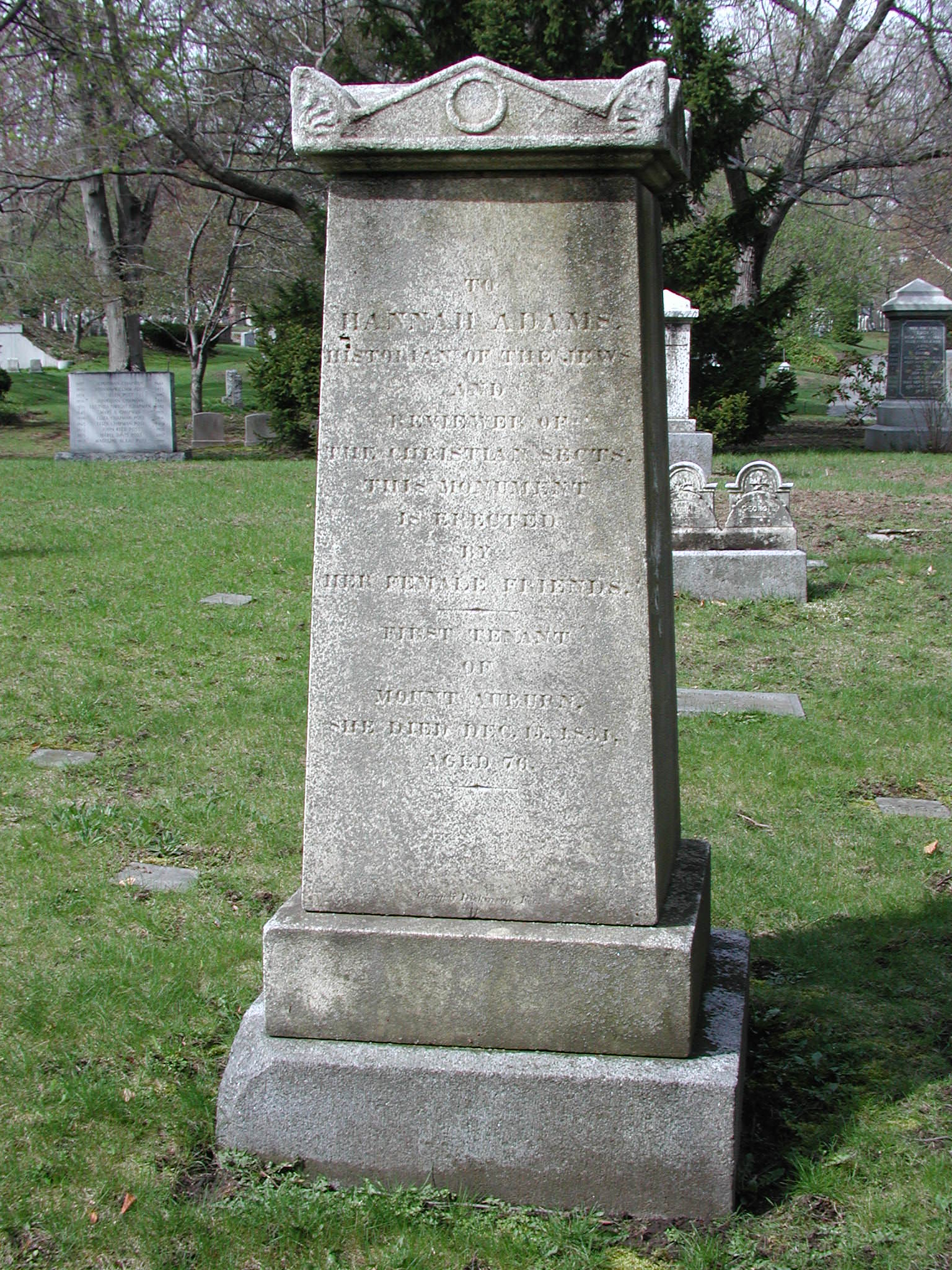
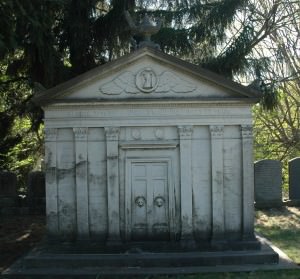
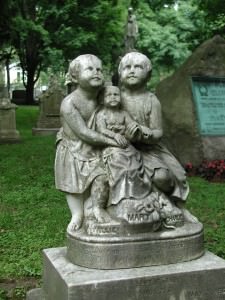
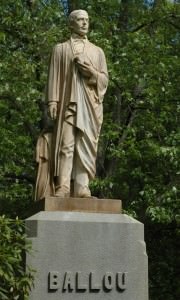
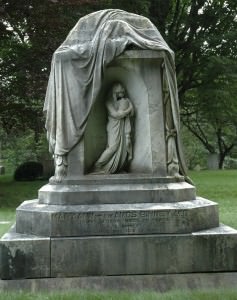
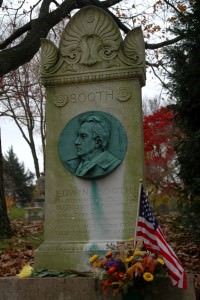
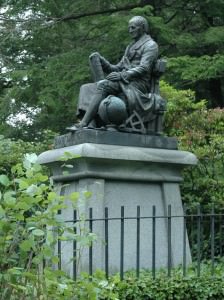
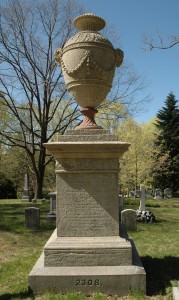
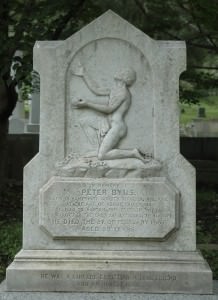
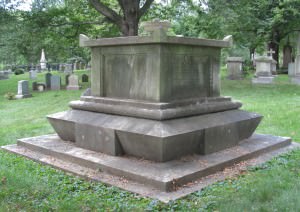
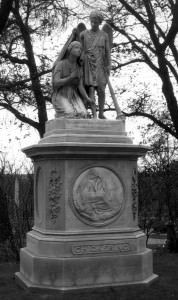
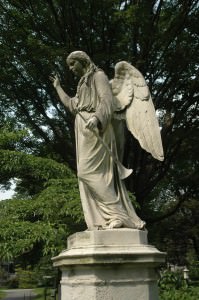
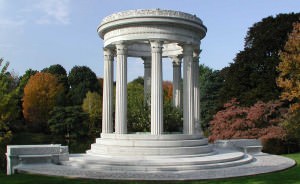
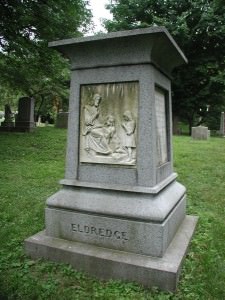

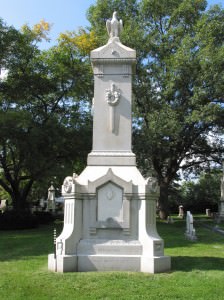
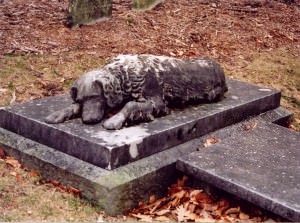
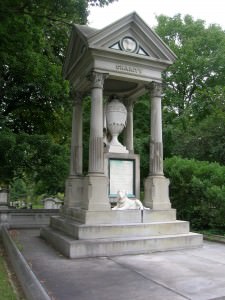
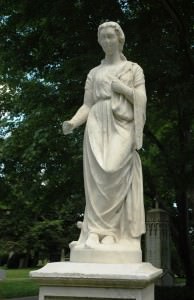
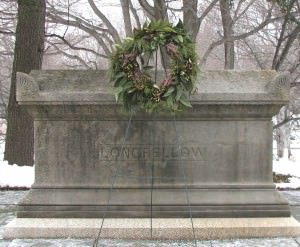

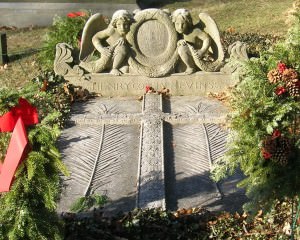
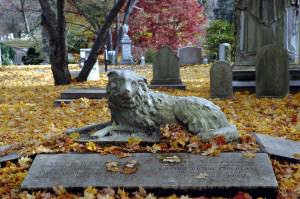
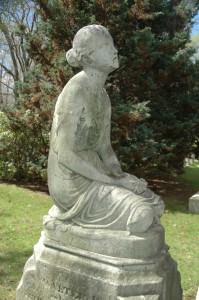
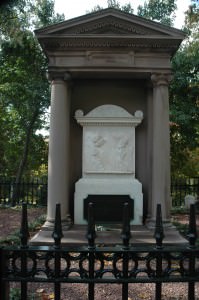
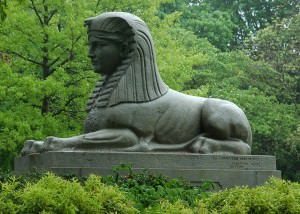

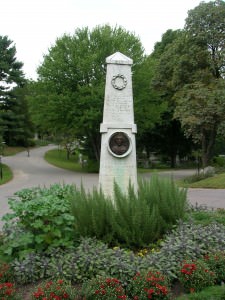
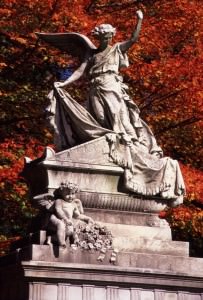
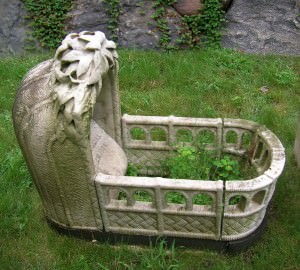
Leave a Reply to Alan Ladbrooke Cancel reply